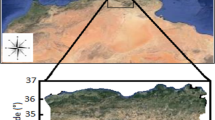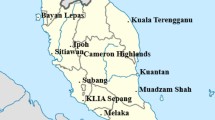Abstract
During recent two decades, Artificial Neural Network (ANN) has become one of the most widely used methods in hydrology. One solution for better capturing the existing non-linear and complex nature of data is to develop new hybrid approaches. These hybrid models can be developed in a way that two or more techniques are combined in order to benefit from the advantages of these available approaches and eliminate their limitations. The main scope of this paper is to improve the performance of rainfall-water level modeling by combining ANN with Self Organizing Map (SOM) as an unsupervised clustering method. The proposed method in this study consists of two phases. In the first phase, with the aim of reducing the complexity and dimensionality of input data, a two-step clustering using SOM technique is carried out. Then, in the second phase, separate ANN models are used to model each cluster of data, and final results are obtained by combining the outputs of all models. The proposed new hybrid approach is evaluated using real hydrological data of Johor River. The results of the study indicate that the new proposed SOM-ANN hybrid model has a better performance in daily rainfall-water level forecasting compared to ANN model alone.





Similar content being viewed by others
References
Abrahart RJ, See L (2000) Comparing neural network and autoregressive moving average techniques for the provision of continuous river flow forecasts in two contrasting catchments. Hydrol Process 14(11–12):2157–2172
Afan HA, El-shafie A, Mohtar WHMW, Yaseen ZM (2016) Past, present and prospect of an artificial intelligence (AI) based model for sediment transport prediction. J Hydrol 541:902–913
Ahmed AN, Noor CM, Allawi MF, El-Shafie A (2016) RBF-NN-based model for prediction of weld bead geometry in Shielded Metal Arc Welding (SMAW). Neural Comput Applic 1–11. doi:10.1007/s00521-016-2496-0
Allawi MF, El-Shafie A (2016) Utilizing RBF-NN and ANFIS methods for multi-lead ahead prediction model of evaporation from reservoir. Water Resour Manag 30(13):4773–4788
American Society of Civil Engineers (2000a) Artificial neural networks in hydrology. I: preliminary concepts. ASCE. ASCE Journal of Hydrologic Engineering 5:115–123
American Society of Civil Engineers (2000b) Artificial neural networks in hydrology. II: hydrologic applications. ASCE Journal of Hydrologic Engineering 5:124–137
Anctil F, Perrin C, Andreassian V (2004) Impact of the length of observed records on the performance of ANN and of conceptual parsimonious rainfall runoff forecasting models. Environ Model Softw 19(4):357–368. doi:10.1016/S1364-8152(03)00135-X
Antar MA, Elassiouti I, Allam MN (2006) Rainfall–runoff modelling using artificial neural networks technique: a Blue Nile catchment case study. Hydrol Process 20(5):1201–1216. doi:10.1002/hyp.5932
Céréghino R, Park YS (2009) Review of the self-organizing map (SOM) approach in water resources: commentary. Environ Model Softw 24(8):945–947
Cervarolo G, Mendicino G, Senatore A (2012) Re-modulating water allocation in a complex multi- reservoir system under current and climate change scenarios. European Water 37:47–57
Corzo G, Solomatine D (2007) Knowledge-based modularization and global optimization of artificial neural network models in hydrological forecasting. Neural Netw 20(4):528–536. doi:10.1016/j.neunet.2007.04.019
De Villars J, Barnard E (1993) Backpropagation neural nets with one and two hidden layers. IEEE Trans Neural Network 4(1):136–141
Dorum A, Yarar A, Faik Sevimli M, Onüçyildiz M (2010) Modelling the rainfall–runoff data of Susurluk basin. Expert Syst Appl 37(9):6587–6593
El-Shafie AH, El-Shafie A, Almukhtar A, Taha MR, El Mazoghi HG, Shehata A (2012) Radial basis function neural networks for reliably forecasting rainfall. Journal of Water and Climate Change 3(2):125–138
Elzwayie A, El-shafie A, Yaseen ZM, Afan HA, Allawi MF (2016) RBFNN-based model for heavy metal prediction for different climatic and pollution conditions. Neural Comput Applic 1–13. doi: 10.1007/s00521-015-2174-7
Heddam S (2016) Secchi disk depth estimation from water quality parameters: artificial neural network versus multiple linear regression models? Environ Process. doi:10.1007/s40710-016-0144-4
Kohonen T (1982) Self-organized formation of topologically correct feature maps. Biol Cybern 43(1):59–69
Kontos YN, Katsifarakis KL (2012) Optimization of management of polluted fractured aquifers using genetic algorithms. European Water 40:31–42
Latt ZZ, Wittenberg H, Urban B (2015) Clustering hydrological homogeneous regions and neural network based index flood estimation for Ungauged catchments: an example of the Chindwin River in Myanmar. Water Resour Manag 29(3):913–928
Maier HR, Jain A, Dandy GC, Sudheer K (2010) Methods used for the development of neural networks for the prediction of water resource variables in river systems: current status and future directions Environ Model Softw 25(8):891–909
Michas S (2014) Applications of hydroinformatics in municipal water systems. Water Utility Journal 8:87–91
Minns AW, Hall MJ (1996) Artificial neural networks as rainfall-runoff models. Hydrol Sci J 41(3):399–417
Mukheibir P, Boyle T, Mitchell C (2013) End-use forecasting in the context of building adaptive water services. Water Utility Journal 6:29–39
Nourani V, Komasi M (2013) A geomorphology–based ANFIS model for multi-station modeling of rainfall–runoff process. J Hydrol 490:41–55. doi:10.1016/j.jhydrol.2013.03.024
Pan T-Y, Wang R-Y (2004) State space neural networks for short term rainfall-runoff forecasting. J Hydrol 297(1):34–50
Sharma SK, Tiwari KN (2009) Bootstrap based artificial neural network (BANN) analysis for hierarchical prediction of monthly runoff in upper Damodar Valley catchment. J Hydrol 374(3):209–222
Singh VP, Cui H (2015) Entropy theory for streamflow forecasting. Environmental Processes 2(3):449–460. doi:10.1007/s40710-015-0080-8
Spiliotis M (2014) A particle swarm optimization (PSO) heuristic for water distribution system analysis. Water Utility Journal 8:47–56
Sulaiman M, El-Shafie A, Karim O, Basri H (2011) Improved water level forecasting performance by using optimal steepness coefficients in an artificial neural network. Water Resour Manag 25(10):2525–2541
Talei A, Chua LH (2012) Influence of lag time on event-based rainfall–runoff modeling using the data driven approach. J Hydrol 438-439:223–233. doi:10.1016/j.jhydrol.2012.03.027
Tigkas D, Christelis V, Tsakiris G (2016) Comparative study of evolutionary algorithms for the automatic calibration of the Medbasin-D conceptual hydrological model. Environmental Processes. doi:10.1007/s40710-016-0147-1
Wang W, Van Gelder P, Vrijling JK, Ma J (2006) Forecasting daily streamflow using hybrid ANN models. J Hydrol 324(1):383–399
Author information
Authors and Affiliations
Corresponding author
Ethics declarations
Conflict of Interest
The authors declare no conflict of interest.
Rights and permissions
About this article
Cite this article
Farzad, F., El-Shafie, A.H. Performance Enhancement of Rainfall Pattern – Water Level Prediction Model Utilizing Self-Organizing-Map Clustering Method. Water Resour Manage 31, 945–959 (2017). https://doi.org/10.1007/s11269-016-1556-7
Received:
Accepted:
Published:
Issue Date:
DOI: https://doi.org/10.1007/s11269-016-1556-7




